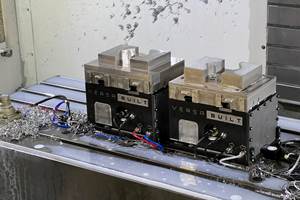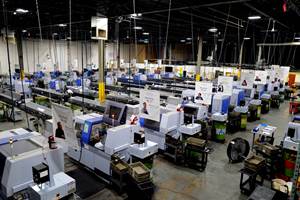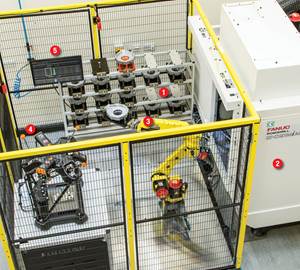Cobots and Beyond
Collaborative robots address a challenge that will continue to be addressed.
Share





Common as robots are in futuristic stories, I know of no story dealing with the challenges real-life robots present. One of these is the challenge of keeping industrial robots from injuring us, either because of their unthinking motions or ours.
In recent years, the commercialization of collaborative robots has made this challenge a topic of interest. Traditionally, the safe use of robots in manufacturing has relied on barriers that keep people and robots separated. Yet that approach is inefficient, consuming floor space for the caged-in area and limiting the work that people and robots can do together. The “cobots” offer a different solution. These robots move without enough speed or force to do harm, and they are force-sensing, stopping in response to any obstruction that might be a person. Are these cobots the way forward for industrial automation?
They are part of the way forward, says John Burg, founder of robotics integrator Acieta. I recently spoke with him at an event focused on collaborative robots at his company’s Iowa headquarters.
An example of an application he has seen in which a cobot makes sense is this: A basket sent into heat treatment gets manually loaded with parts. Various different baskets have warped differently after many heat-treat cycles, so automated loading of the baskets is problematic. However, a robot lifts each basket of parts once it is full. Here, collaborative technology makes it safe and simple for a person and a robot to complete the task together.
But in a different application in which the user was initially focused on a collaborative robot, in this case for part loading, Mr. Burg says the user’s productivity called for a narrow cycle time target for the robot. As it happened, the cobot’s limited speed proved too slow to meet that need.
This points to a challenge with the new technology, he says. Because it is new, and because it offers some manufacturers a promising new way to use robots, many are rushing to cobots in applications where they arguably don’t make sense.
Another speaker at the Acieta event was Claude Dinsmoor, general manager for material handling robotics with FANUC America. His company’s cobots were running in part-loading demonstrations at this event. (I let one hit me to see its responsive stopping.) He, too, says collaborative robots are an important development, but not the final answer to the safety challenge. Indeed, he tells a futuristic story of his own.
One solution already in use today, he notes, is the “fenceless” robot. Sensors used in conjunction with a robot at full speed and power can enable it to slow if a person comes near and stop if a person comes very close. How much further could this idea go?
Maybe the day will come when something like a collaborative robot is not collaborative all the time, but instead has limitations that reliably activate when people are in proximity. In the future, he says, perhaps it will be advances in the sensitivity, specificity and responsiveness of sensors that will allow fast, forceful robots to unguardedly operate within the same production space where people also work.
Related Content
Using Automation to Reduce COGS and Stay Globally Competitive
Decade-long, multiphase automation investments lower operating costs and maintain technology lead in an increasingly competitive global market.
Read MoreUsing Jaws as Grippers Enables Flexible, Low-Cost Automation
VersaBuilt’s automation systems significantly boosted Innovative Fabrication’s revenue. In return, the shop has helped VersaBuilt optimize its products.
Read MoreInside the Premium Machine Shop Making Fasteners
AMPG can’t help but take risks — its management doesn’t know how to run machines. But these risks have enabled it to become a runaway success in its market.
Read More5 Stages of a Closed-Loop CNC Machining Cell
Controlling variability in a closed-loop manufacturing process requires inspection data collected before, during and immediately after machining — and a means to act on that data in real time. Here’s one system that accomplishes this.
Read MoreRead Next
A New Frontier in Surface Finish Control
What if your machine tool could measure surface roughness as it cuts? This article explores how in-process metrology is advancing from concept to reality, enabling real-time feedback, immediate detection of anomalies and new levels of control over surface quality. Discover the technologies making this possible.
Read MoreHow I Made It: Dennis Rymanowski
Dennis Rymanowski has worked at NSH USA for 60 years, with his passion for manufacturing living alongside his passion for his family’s polka band.
Read More




















